Uniting (formerly Methodist) Church
William Street, Bathurst
William Davidson, Sydney, 1874 and 1887
Restored 1991 Roger H. Pogson Pty Ltd, Orange
2 manuals, 16 speaking stops, mechanical and
tubular-pneumatic action

Bathurst Uniting Church
Photograph by Trevor Bunning (March 2007)
Historical and Technical Documentation by Kelvin Hastie
© OHTA 1990 (updated May 2007 and March 2024)
In the nineteenth century the Wesleyan Methodists of New South Wales established their most successful rural causes in Goulburn, Maitland and Bathurst. A small chapel was built at Bathurst in 1837 and still stands adjacent to the main building. The present building was built on the "Methodist Model Plan" and opened in 1860. The galleries, external tower and organ with its lower vestries, were all later additions. The building is one of the few galleried churches in this style to survive in Australia.
For many years the origin of the magnificent organ in the church remained a mystery. In 1978 a thorough search of old Methodist newspapers (The Christian Advocate and Wesleyan Record and The Weekly Advocate) revealed the identity of the organ.
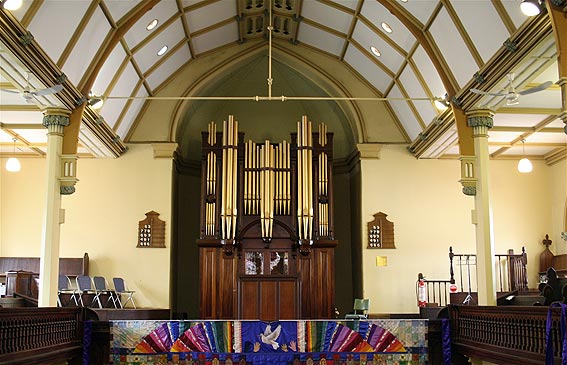
The following account described the organ as built by William Davidson and opened on 13-15 March, 1874:
"The new organ, built by Mr Davidson of Pyrmont, on the model of Bourke Street organ was on the days named brought into use for the worship of God and the assistance of his people in divine service. The Organ is finished in the most workmanlike manner, and certified by judges of such things to be a great credit to the builder, and the colony. It has been placed on a platform built for it at the south end of the church, so that it is in full view of the congregation. For the opening services the committee fortunately secured the help of Mr. F. Morley, of Bourke Street. This gentleman has taken great interest in the organ during the time of its being built at Pyrmont, and kindly gave his services to introduce the organ to the church in Bathurst. These services were performed in Mr. Morley's best style, and to the unbounded delight of all concerned...
The musical service was opened with a voluntary which drew at once rapt attention. The President then took the chair and first called upon Rev. F. W. Ward to read a Psalm, and the Rev. G. Woolnough to offer a prayer. Mr Morley then played a beautiful solo, which brought out the sweetness and power of the organ. This was followed by "Denmark" given by the organ and large choir under the direction of Mr. G Smith... the entire cost of the organ and platform, together with various incidental expenses amounted to about £390."1
This instrument was one of the earliest pipe organs in a Methodist building in New South Wales - earlier examples were located at York Street, Bourke Street and Wesley Church, Chippendale. Some prejudice had to be overcome before such instruments were found acceptable in Methodist churches. The casework, clearly similar to the Bourke Street organ (now at Wesley Uniting Church, Wollongong), is an impressive example of the skill of local joiners, with many superbly executed decorative elements. The case basically comprises three towers, with two outer double-storey flats divided by large carved rosettes. An arch is placed behind a central flat of pipes, with carved timber bracing found higher up, stretching across the central flat, all three towers and to the outer flats. Carved pine cones are found beneath the outer towers, but with the central tower standing above an ornate pendant.
In 1887 Davidson enlarged the organ and installed a pneumatic pedal action. After the completion of the galleries in the church, the organ was moved into the present apse with its acoustic shell. This location, without doubt, does much to enhance the projection of tone from the organ. The reference to this change in the position of the organ reads as follows:
"Sermons were preached in the Wesleyan church, William Street, on Sunday, December 18th [1887], in connection with the anniversary... The congregations were large, a special feature of the services being the singing, the choir having been supplemented for the occasion by additions from the Presbyterian and Church of England choirs, the organ being used for the first time since its enlargement. A large recess has been built behind the spot previously occupied by the instrument, and the additions consist of a complete pedal organ, consisting of sound boards with tubular pneumatic action, carrying the following stops, one open diapason, 16 feet, 30 notes; two bourdon 16 feet tone, 30 notes. An open diapason, 8 feet, has also been added to the swell organ, the oboe revoiced, as also one of two of the other stops. The alterations have been effected in the best style by Mr Davidson, of Sydney, the original builder, and greatly increased the power has thus been secured. Several high-class anthems were sung during the services. Mr. F. Morley, of Sydney, and Mr. C. Toole alternately presided at the instrument."2
In 1919 it was reported in the The Methodist that the organ had been overhauled, this process having taken John B. Holroyd six months to complete. Holroyd dismantled the entire organ, rebuilt the pedal pneumatic action, fitted new stopknobs and made other minor changes. At some stage the unison rank of the Great Mixture II was removed and in the mid-1950s S.T. Noad & Son fitted a tremulant.
By 1982 it became obvious that the organ would require restoration as it was simply wearing out. An organ fund was established and numerous concerts were arranged by the organist, Mrs Judith Brooke. In 1988 the church was successful in securing a grant from the Heritage Council of NSW and further funding was forthcoming from the Bicentennial Council. Quotes were sought from two organbuilders and Roger H. Pogson was awarded the contract to restore the organ, with Kelvin Hastie acting as consultant.
A considerable amount of labour was involved in the restoration - the following list summarises the work undertaken by Pogson:
1. Repair of all pipework. The metal pipes, all made by Davidson in his Pyrmont factory, are of excellent quality and did not require substantial repairs. As Rank 1 (the unison) of the Mixture was missing, Pogson supplied 56 new pipes to complete the stop.
2. Restoration of the manual windchests, replacing any worn parts and renewing springs, pulldown wires, etc. The soundboards were found to be of sound design and construction.
3. Repair of tracker action components. Much wear had taken place in the action, especially in the pedal coupler section. Some minor alterations were required to some of the coupler action.
4. Rebuild of pedal pneumatic action. This action had been modified by Holroyd and was inefficient. The pneumatics were redesigned in a sympathetic style using ribbed oblong motors to replace the circular purses which had been very poor in operation. The touchbox at the pedals was restored.
5. Recovering of the bellows, repair of the wind system and installation of a new blower.
6. Repair of the casework and console. Much of the case was badly out of alignment - a result of the organ being twice previously dismantled. Substantial rectification of this problem has been necessary. Alignment problems with the action components have also been amended. Much of the area around the console was heavily worn and substantial timber restoration and the replacement of damaged sections have been necessary. Some components such as the balanced swell pedal and the drawknob rods have had to be completely replaced due to excessive wear.
In 1991 Roger Pogson completed his work and the organ was re-opened on 20 October that year, with the guest recitalist being Dr Christopher Dearnley, LVO, with his wife, Bridget, associate artist, playing the 'cello. The Dearnleys has retired to Australia, Christopher having been organist of St Pauls' Cathedral, London in the period 1968-90.
At all times, respect for the historical authenticity of this organ was a theme at the centre of the work. Replacement was generally in facsimile of the original and any alterations were minor and executed in a style that honoured the original. The instrument shows Davidson to have been a master of tonal finishing - the organ has always been well-known for its exceptional choruses and the beauty of its flutes.
Thankfully, several of Davidson's other instruments survive in recognisable form. These notably include the instruments in the Anglican Churches at Lavender Bay (1872), Cobbitty, Murrurundi and Yass (1876), Morpeth (1877), Burwood (1890), Ryde (1892) and Erskineville (1905), as well as the instruments at the Presbyterian Ladies' College, Croydon (1901) and the Protestant Church, Noumea, New Caledonia (1873). Davidson's two largest works (St James' Anglican Church, King Street, Sydney – itself a rebuild of earlier work and St Thomas' Anglican Church, North Sydney) were extensively rebuilt beyond recognition, with the St James' organ now broken up and replaced by a new pipe organ and the St Thomas' instrument standing idle, with an electronic in use.
Since 1991, a considerable amount of dirt and dust built up inside the Bathurst organ and so in 2023 Murray Allan (assisted by Thomas Glastonbury and David Powis) was engaged to clean the organ, make a number of repairs and to repolish the casework.
On 10 March 2024 a service and concert commemorating the 150th anniversary of the organ's opening was held in the church, featuring guest organist, Christopher Wrench, of Brisbane. The Allegri Singers and the Orange Regional Conservatorium Choir, directed by William Moxey also performed at the afternoon concert. During the service, Mrs Judith Brooke, who served the church as organist since her appointment as Deputy Organist in 1962 (and as organist some three years later), was acknowledged for her extraordinary commitment to the church over an extended period of time.
There can be no doubt that the Bathurst Davidson shows the builders' chorus work to best advantage and the fact that the pipework has survived, with cone tuning retained for its open metal fluework, enhances the importance of the instrument. The organ was recognised as being of significance to the cultural heritage of New South Wales and, with the church and adjacent chapel, it was placed on the State Heritage Register on 17 March 2022 (gazetted as SHR 02058) by the NSW Department of Environment and Heritage.
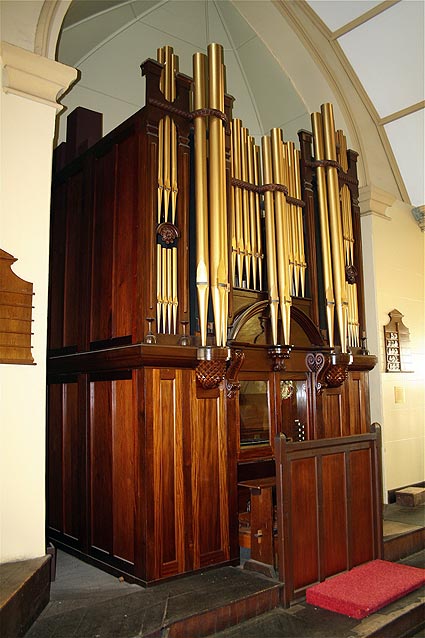
The specification is:
| Great Bourdon Open Diapason Stop Diapason Dulciana Principal Wald Flute Fifteenth Mixture Swell Open Diapason Lieblich Gedacht Voix Celeste Gemshorn Flautina Oboe Tremulant Pedal Open Diapason Bourdon Couplers Great to Pedal Swell to Pedal Swell to Great |
16 8 8 8 4 4 2 II 8 8 8 4 2 8 16 16 |
+ + #^ *^ # # |
+ From c0 (C-B of Dulciana from Stop Diapason)
^ From g0 (C-B from Lieblich Gedacht)
# Added by Davidson, 1887
* Original Gamba label replaced by John B. Holroyd in 1919. Pipes still sound as Gamba.
Mixture composition:
C – b0: 19.22
C1 – g3: 12.15
Compass 56/29
Tracker action to manuals
Tubular-pneumatic to pedals
Hitch-down swell pedal3
Pitch 445.6 Hz at 27˚ C
(measured by John Stiller, February 1983
Number of pipes=858
1 The Christian Advocate and Wesleyan Record, April 1, 1874, 16.
2 The Weekly Advocate, January 7, 1888, 414.
3 Specification noted 1975 Kelvin Hastie
|
|
||
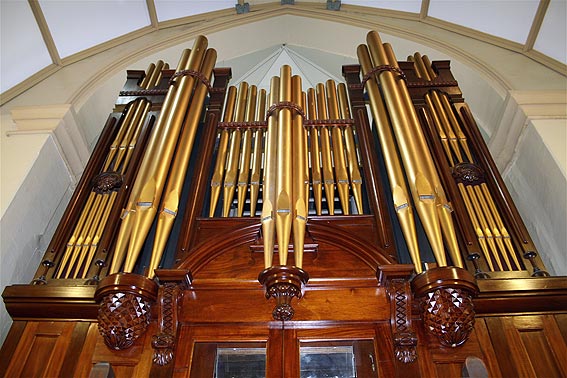 |
||
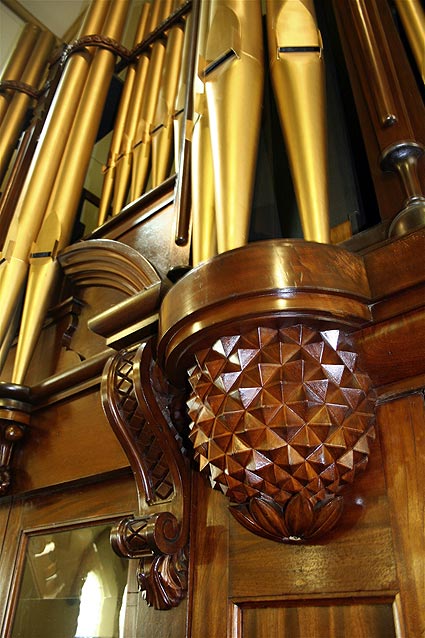 |
||
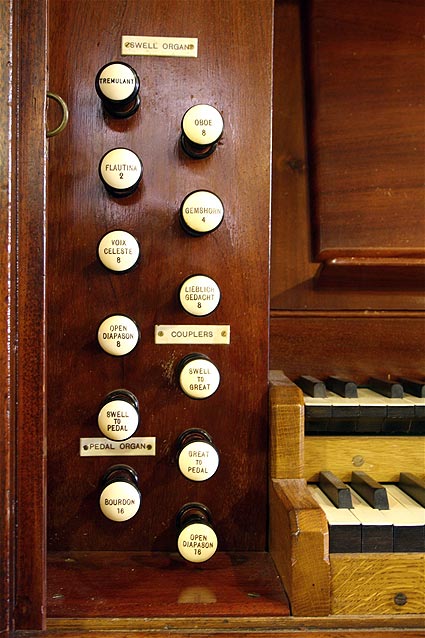 |
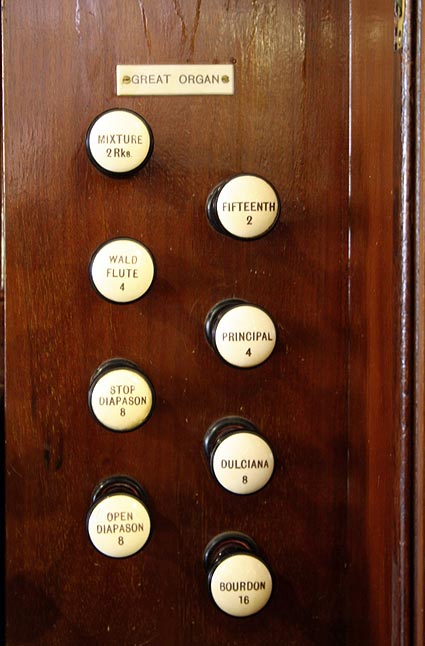 |
|
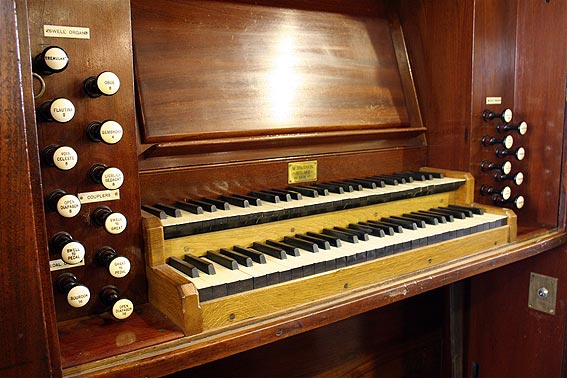 |
||
 |
||
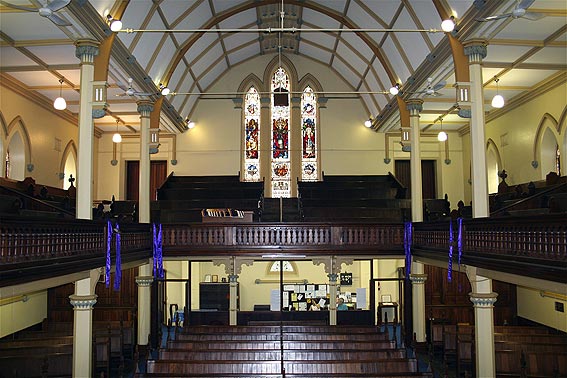 |
||
Photos: Trevor Bunning March 2007